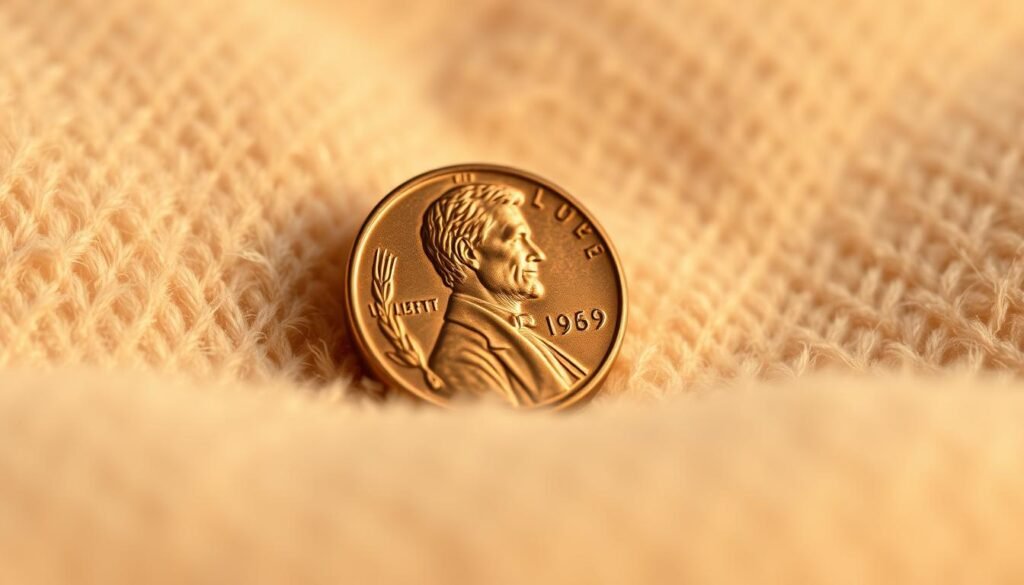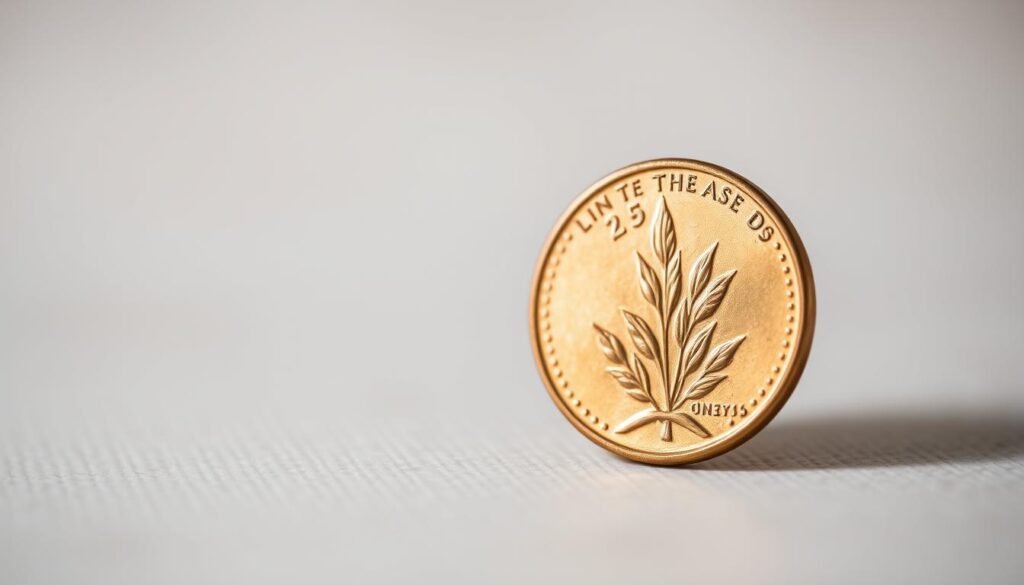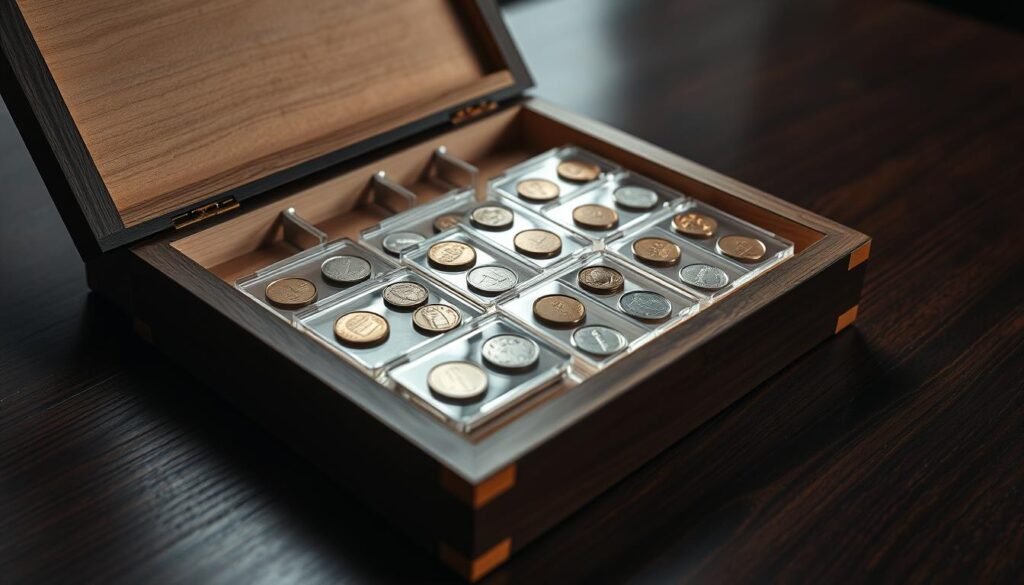The 1956 D Wheat Penny is a prized coin among collectors. Its historical importance and rarity make knowing its value key. To understand its worth, you need to know about its production, physical details, and market demand.

The value of a 1956 D Wheat Penny changes based on several things. These include its condition, how rare it is, and how much people want it. This article will help you figure out what your 1956 D penny is worth. We’ll cover its history, how to keep it in good shape, and selling it.
Key Takeaways
- The 1956 D Wheat Penny is a rare and highly sought-after coin among collectors.
- Its value depends on factors such as condition, rarity, and market demand, affecting the wheat penny value.
- Understanding the coin’s production, physical characteristics, and market demand is crucial for determining its worth, specifically for the 1956 D penny.
- The 1956 D Wheat Penny is a significant part of American numismatic history, influencing its wheat penny value.
- Proper preservation and storage can help maintain or increase the coin’s value over time, which is essential for the 1956 D penny.
History of the 1956 D Wheat Penny
The 1956 D Wheat Penny is a key coin in coin collecting and numismatics. Its history is crucial to grasp its value and importance. The Denver Mint made this coin, known for its wheat design, symbolizing America’s agricultural wealth.
The Denver Mint’s role in making the 1956 D Wheat Penny is key. The coin’s mintage numbers also play a big part in its rarity and value. For those into coin collecting, knowing the 1956 D Wheat Penny’s history is vital.
Key Facts About the 1956 D Wheat Penny
- Produced at the Denver Mint
- Features two stalks of wheat on the reverse side
- Mintage numbers affect its rarity and value
In coin collecting and numismatics, the 1956 D Wheat Penny is highly prized. Its unique design and historical importance make it a valuable find. Whether you’re new or experienced, knowing the 1956 D Wheat Penny’s history is essential.
Physical Characteristics of the 1956 D Wheat Penny
The 1956 D Wheat Penny is a favorite among vintage coins collectors and penny collection enthusiasts. To spot and confirm this coin, knowing its physical traits is key. It shows Abraham Lincoln on one side and wheat stalks on the other. The coin also has “ONE CENT” and the “D” mint mark for Denver.
Some important features of the 1956 D Wheat Penny are:
- Material: Copper-plated zinc
- Diameter: 19.1 mm
- Weight: 3.11 grams
- Edge: Plain
These details help tell the 1956 D Wheat Penny apart from other coins. They also show its condition, which affects its worth. Knowing these traits is crucial for collectors, whether you’re new or experienced in penny collection.
In the realm of vintage coins, the 1956 D Wheat Penny is a prized find. Its distinct physical features make it a highlight in any penny collection. Learning about these traits helps you appreciate and identify this iconic coin.
Understanding the D Mint Mark
The D Mint Mark is key to identifying the 1956 D Wheat Penny. It shows the coin was made in Denver. Denver is famous for making high-quality and rare coins.
Coins from Denver are often more valuable. This is because they are made in smaller numbers and have unique features.
The D Mint Mark is vital when figuring out a 1956 D Wheat Penny’s worth. It helps show if the coin is real and rare. This can greatly affect its value.
A 1956 D Wheat Penny with a real D Mint Mark is considered rare. Its value is usually higher than coins without a mint mark or fake ones.
- Location: The D Mint Mark is on the coin’s back, below the wheat stalks.
- Font style: The mint mark’s font should match the Denver Mint’s original style.
- Size: The mint mark’s size should be the same as the Denver Mint’s original size.
By checking these, you can tell if the D Mint Mark is real. This helps figure out the coin’s worth as a rare find.
1956 D Wheat Penny: How Much Is It Worth?
The worth of a 1956 D Wheat Penny depends on its condition, rarity, and demand. To get a precise coin appraisal, these factors must be considered. The coin’s value can vary from a few cents to a lot, based on its grade and if it’s been used or kept as is.
It’s important to know what affects a rare penny‘s value. This knowledge is key for both those buying and selling. Key factors include:
- Condition: The coin’s state, including its grade and any wear or damage.
- Rarity: The coin’s uniqueness, including its production numbers and special features.
- Demand: How much people want the coin, including its appeal to collectors and historical importance.
A professional coin appraisal is vital for figuring out a rare penny‘s worth, like the 1956 D Wheat Penny. By looking at these factors and getting a detailed appraisal, buyers and sellers can make smart choices about this valuable coin.

Grading Your 1956 D Wheat Penny
Grading a coin is key in coin collecting and numismatics. The 1956 D Wheat Penny is no different. It involves checking the coin’s condition and looking for wear. You need a sharp eye and to know the coin well.
The grade of a coin can greatly affect its value. For the 1956 D Wheat Penny, grading is detailed. It looks at the coin’s state, from uncirculated to circulated. The coin’s grade is vital for its value.
Understanding Grades
There are several grades for the 1956 D Wheat Penny. These include:
- Uncirculated grades, for coins never used in daily life
- Circulated conditions, for coins used in everyday transactions
- Professional grading services, for an unbiased coin assessment
For those into coin collecting and numismatics, knowing these grades is crucial. It helps determine the 1956 D Wheat Penny’s value. By checking the coin’s condition and grade, collectors can make smart choices.
Professional Grading Services
Professional grading services offer an unbiased look at a coin’s grade. This is key for knowing its value. They use a set grading system to judge the coin’s condition and give a quality score.
Common Issues and Errors
Collecting vintage coins comes with knowing about common problems. The 1956 D Wheat Penny is no different. Understanding these issues helps spot unique coins and check their authenticity in your penny collection.
Issues with the 1956 D Wheat Penny include misprinted dates and misaligned dies. These problems can be small or big, making the coin rare and valuable.
Here are some common issues to watch for:
- Misprinted dates: This can include incorrect dates or dates that are not properly aligned.
- Misaligned dies: This can cause the coin’s design to be misaligned or distorted.
- Minor errors: This can include small scratches, dents, or other minor imperfections.
Knowing about these common issues helps collectors value and appreciate their penny collection and vintage coins more.
Factors Affecting Value
The value of a coin, like the 1956 D Wheat Penny, depends on several key factors. These factors can greatly change the coin’s worth. To grasp the value of the 1956 D Wheat Penny, it’s crucial to look at its condition, market demand, and rarity.
When checking a coin’s condition, collectors and enthusiasts search for wear and minting errors. The coin’s condition greatly affects its value. Uncirculated coins are usually more valuable than those that have been used. The demand for rare coins, like the 1956 D Wheat Penny, can also change. This is due to the interests of collectors and enthusiasts.
Some important factors that influence the value of the 1956 D Wheat Penny include:
- Condition: The state of the coin, including any signs of wear and tear.
- Market demand: The level of interest in the coin among collectors and enthusiasts.
- Rarity: The scarcity of the coin, including any errors or unique features.
These factors can all affect the coin’s worth, making some rare coins very valuable. By understanding these factors, collectors and enthusiasts can better assess the value of the 1956 D Wheat Penny and other rare coins.
Preservation and Storage Tips
To keep your 1956 D Wheat Penny in top shape, it’s key to handle and store it right. A coin appraisal can tell you its worth. But, taking care of it is more important to keep its condition. Always wear gloves when touching your rare penny to avoid oil damage.
Don’t touch the coin’s surface as it can harm it and lower its value. Hold the coin by the edges to avoid any damage. For storage, use coin albums or capsules made to protect coins from harm and moisture.

- Coin albums with acid-free pages
- Airtight capsules to prevent moisture damage
- Storage boxes with individual compartments to prevent coins from touching
By following these tips, you can keep your 1956 D Wheat Penny in great shape. Whether you’re a seasoned collector or just starting, proper care and storage are crucial. They help protect your investment and keep your rare penny looking good for years.
Where to Sell Your 1956 D Wheat Penny
When you want to sell your 1956 D Wheat Penny, picking the right place is key. The wheat penny value changes based on its condition, rarity, and demand. So, it’s important to pick a way to sell that highlights your coin’s special features. You can sell on online marketplaces, in coin shops, or at auction houses.
Online marketplaces let you reach a wide audience and have competitive bids. Coin shops offer expert advice and a focused crowd. Auction houses can get your coin seen by many and might offer higher prices, but they charge more fees. Think about these choices when you decide where to sell your 1956 D Wheat Penny:
- Online marketplaces: eBay, CoinWorld, and other online platforms
- Specialized coin shops: Local coin dealers and numismatic stores
- Auction houses: Major auction houses like Heritage and Stack’s Bowers
To get the best wheat penny value for your 1956 D Wheat Penny, do your homework. Understand the different selling options. By picking the right place and showing off your coin well, you can draw in buyers and get a good price.
Conclusion: Is the 1956 D Wheat Penny a Good Investment?
The 1956 D Wheat Penny is a coin that grabs your attention. It has historical value and could increase in value over time. Whether you’re new to coin collecting or experienced, this penny is a great choice for your collection.
This coin stands out because of its low production numbers and unique Denver mint mark. It’s a great pick for anyone wanting to add something special to their collection. The 1956 D Wheat Penny is not just an investment; it’s a piece of history and art.
FAQ
What is the value of a 1956 D Wheat Penny?
The value of a 1956 D Wheat Penny varies. It depends on its condition, rarity, and demand. Uncirculated coins in good shape can be worth hundreds or thousands. Circulated coins might only be worth a few cents.
How can I identify an authentic 1956 D Wheat Penny?
Look for the “D” mint mark on the back of the coin. This shows it was made at the Denver Mint. Check the coin’s design, material, and quality to make sure it’s real.
What are the key factors that affect the value of a 1956 D Wheat Penny?
The value depends on the coin’s condition, rarity, and demand. Uncirculated coins in great shape are more valuable. Circulated coins with wear are worth less. Rarity, based on mintage and errors, also affects the value.
How can I grade my 1956 D Wheat Penny?
Grading means checking the coin’s condition and quality. Uncirculated coins get a grade from MS-60 to MS-70. Circulated coins are graded from Poor (P-1) to Mint State (MS-70). For a professional evaluation, use a reputable service.
Where can I sell my 1956 D Wheat Penny?
You can sell your coin online, at coin shops, or through auction houses. Each place has its own benefits, like reach and fees. Choose the best option for your coin and selling goals.
What are some common issues or errors found in 1956 D Wheat Pennies?
Common issues include misprinted dates and misaligned dies. These can make the coin more valuable to collectors. Knowing about these issues helps in authenticating and valuing your coin.
How should I properly handle and store my 1956 D Wheat Penny?
Always wear cotton gloves to avoid oils and fingerprints. Store the coin in a protective holder, like a coin album or capsule. This keeps it safe from damage and maintains its value.